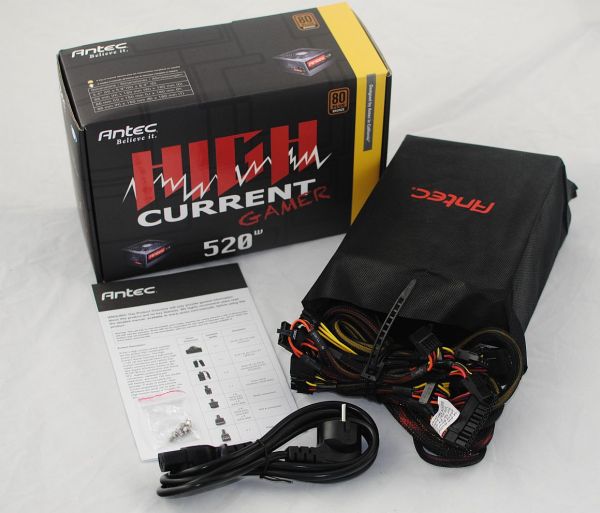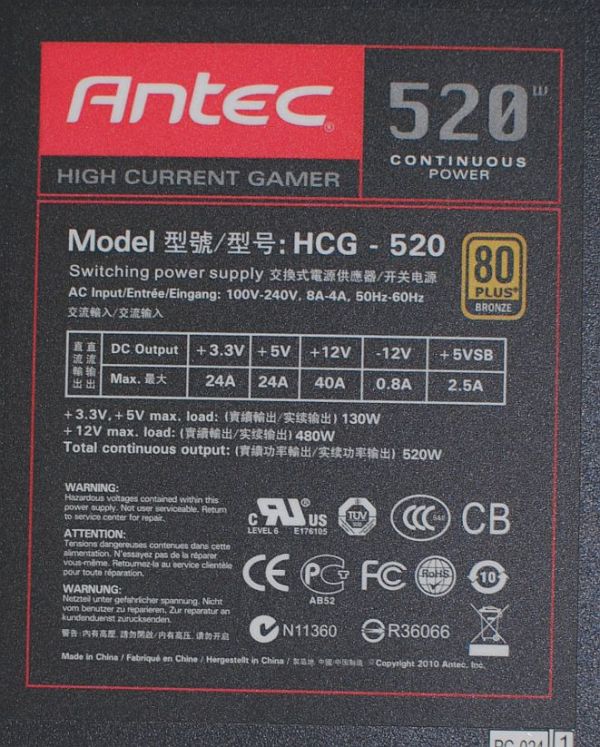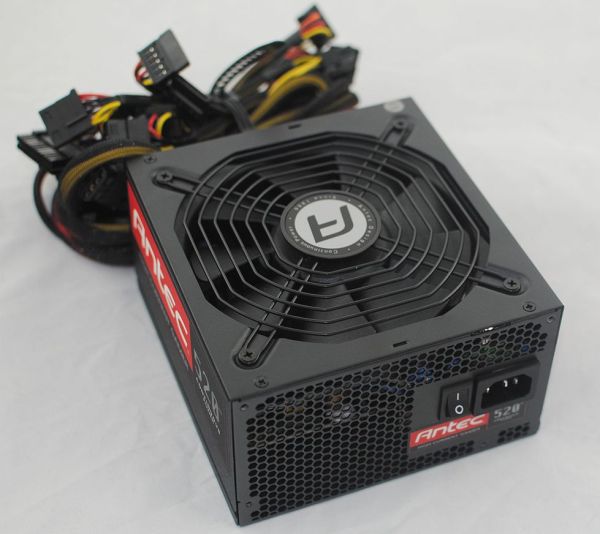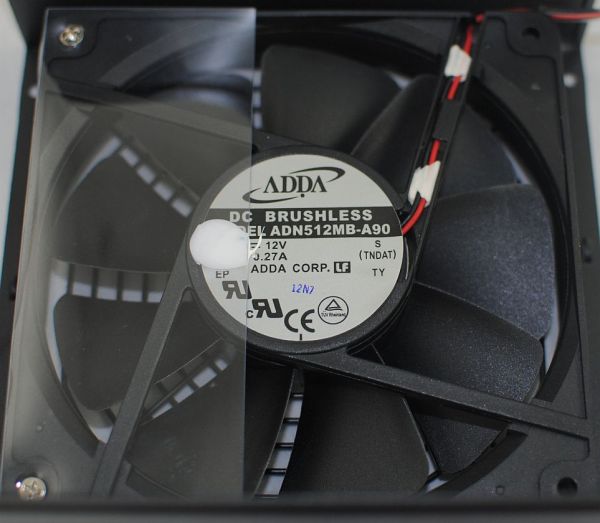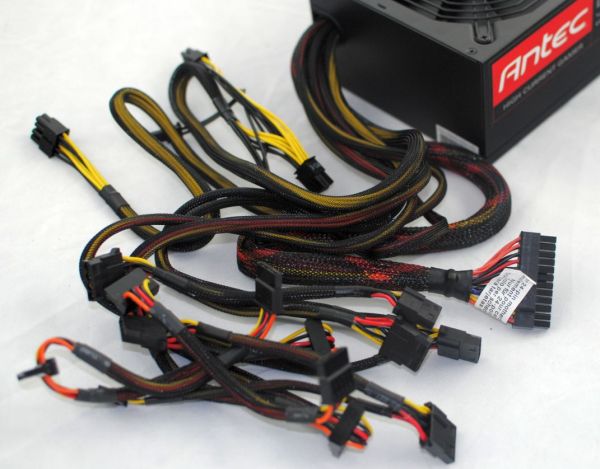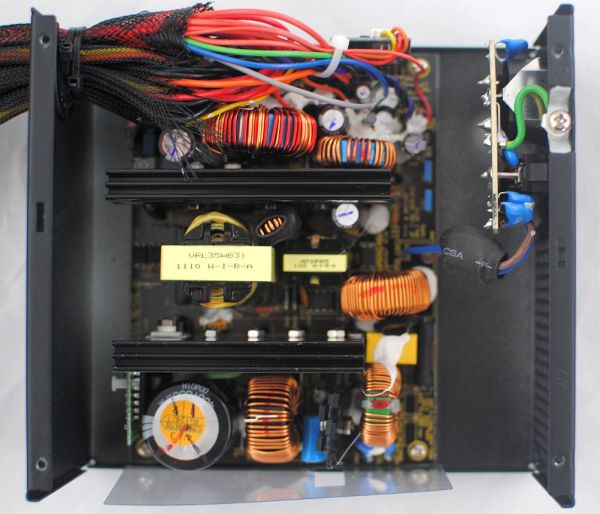
Original Link: https://www.anandtech.com/show/4343/antec-hcg-520-good-bargain
Antec HCG 520W: A Good PSU for Bargain Hunters
by Martin Kaffei on May 31, 2011 6:55 PM ESTAntec's HCG 520W PSU
Antes seems content to continue releasing non-modular products, and like the larger HCG-750, the HCG-520 comes with 80 Plus Bronze certification. We have already tested the 750W version, so it will be interesting to compare the two units and see what other changes are in store beyond the rated power output.
The delivery contents are identical to the 750W version. There is one manual, some screws, and a power cord. In contrast to the HCG-750, the 520W model only has a 3-year warranty (instead of five) and there aren't quite as many cables and connectors. The case is 160mm long, so it is also much shorter than its big brother.
The 520W unit can theoretically draw up to 8A from the power grid (115VAC), and it delivers up to 40A on the single +12V rail. The maximum output from 12V is thus 480W if you don't stress the other rails, which are both rated at 24A. Together, 3.3V and 5V can deliver an additional 130W, which is more than enough for a system with modern components such as SSDs. By way of comparison, the HCG 750W has four 12V rails that can deliver up to 40A, along with a more powerful standby rail.
The packaging lists OCP, OVP, SCP, and OPP safety features, so the power supply should be safe. Interesting to note is that UVP isn't listed. The PWM/PFC IC has it's own under voltage protection while the PS223 IC delivers this feature on all outputs; Antec could benefit from listing these additional features on their homepage. Anyway, let's find out if the PSU itself needs to be improved.
Appearance and Fan
The black finish is pretty typical these days, but the red accents add a nice touch. The fan grille also mixes things up by using a slight octagonal cutout. The ventilation holes at the back are honeycombed and there is a small power switch beside the AC inlet. At 160mm in length, this is a relatively small case and will work well in smaller enclosures. Personally, I think the design of this model is more professional than that of the HCG-750, so hopefully Antec continues to use this design.
ADDA is an often used company that delivers decent fans for power supplies. This ball bearing type has the model number ADN512MB-A90. This 135mm fan can spin at up to 1700RPM, so it shouldn't get too loud. The nine fan blades are well-made but overall it won't be able to surpass a Sanyo Denki fan.
Cables and Connectors
The cable sleeving for most strands is made from a very cheap material; however, even cheap sleeving is better than nothing. You can see the yellow cables up top that support the CPU and graphics cards. They are very long for a PSU in this price range, which is useful for cases with bottom-mounted PSUs. Even if this PSU has no modular cables, the extra length means you can better route the cables to keep your PC looking tidy. There are also fewer cables with the 520W PSU compared to the 750W version, so it should be easier to tuck any unneeded cables out of sight.
| Cables and Connectors | ||
| Fixed | Main | 24-pin 55cm |
| ATX12V/EPS12V | 4+4-pin 60cm | |
| PCIe | 2x 6/8-pin 50 +15 cm | |
| Peripheral | 3x SATA 55-85cm / 3x SATA 55-85cm | |
| 3x Molex 55-85cm / 3x Molex, 1x FDD 55-100cm | ||
Seasonic is the master of long cables and it seems to continue here since they are the ODM for this PSU. These aren't the longest cables we have ever seen but the length is nice for an affordable 520W PSU like this one. Keep in mind that the cost of a few extra cables and connectors can quickly add up, so every connector more than the competition brings added value. The HCG-520 provides six SATA and Molex connectors, along with one FDD plug. The only complaint we have is that both PCIe connectors share one cable with a common wire cross-section. We wouldn't recommend such a setup for the highest power GPUs, though of course both AMD and NVIDIA recommend more powerful PSUs for products like the HD 6970, HD 6990, GTX 580, and GTX 590.
Interior
This is a different layout than that of the HCG-750. The PCB is much shorter and there is a lot of free space in the case (which makes the PCB spacer on the left useless). We can see two thin heatsinks for the transistors and diodes so the fan can easily direct airflow at all the components. The rectifier bridge has its own heatsink for cooling. The overall impression is good but the distances between some circuit parts could be larger--specifically the linear choke behind the phase and neutral conductor could be a source for magnetic coupling on the standby rail. Another point of criticism is the PFC choke that needs more glue to affix it. These are relatively minor concerns and tend to go with the target market; let's continue with some positive aspects.
The EMI filtering is equipped well including a MOV for overvoltage protection. The ferrite core on the conductors helps to reduce EMC troubles with high frequency current. The main cap is from SMQ with 85°C and 330 μF, and the Infineon ICE1CS02 controls the Power Factor Pre-regulator. We can find four identical transistors with common ratings: two for PFC and two for the "Two Transistor Forward" design. In the secondary circuit are 105°C caps from Nippon Chemi-Con as well as a PS223 for the safety functions. The PS223 provides all the earlier mentioned mechanisms like OCP for four rails and UVP.
Voltage Regulation
| +3.3V Regulation | |
| Load | Voltage |
| 10% | +2.42% |
| 20% | +2.12% |
| 50% | +1.21% |
| 80% | +0.61% |
| 100% | +-0% |
| 110% | -0.61% |
| +5V Regulation | |
| Load | Voltage |
| 10% | +1.80% |
| 20% | +1.40% |
| 50% | +0.60% |
| 80% | -0.20% |
| 100% | -1.40% |
| 110% | -1.80% |
| +12V Regulation (Worst Rail) | |
| Load | Voltage |
| 10% | +1.92 % |
| 20% | +1.75 % |
| 50% | +1.50 % |
| 80% | +0.42 % |
| 100% | +0.33 % |
| 110% | +0.17 % |
Like most PSUs the Antec HCG 520W has a low voltage drop on +12V; even at overload the voltage is above 12.00V, which is a good sign for a strong single rail. The other rails also perform well. +3.3V starts high but that shouldn't be a problem since the measurement is still within specification. +5V ends like it starts with a 1.8% difference to the optimal value.
Ripple and Noise
| +3.3V Ripple Quality | |
| Load | Ripple and Noise |
| 10% | 7mV |
| 20% | 8mV |
| 50% | 10mV |
| 80% | 11mV |
| 100% | 13mV |
| 110% | 16mV |
| +5V Ripple Quality | |
| Load | Ripple and Noise |
| 10% | 5mV |
| 20% | 6mV |
| 50% | 8mV |
| 80% | 9mV |
| 100% | 10mV |
| 110% | 11mV |
| +12V Ripple Quality (Worst Rail) | |
| Load | Ripple and Noise |
| 10% | 9mV |
| 20% | 11mV |
| 50% | 12mV |
| 80% | 20mV |
| 100% | 35mV |
| 110% | 38mV |
The HCG-520 shows slightly better results than the 750W version. +12V stays under 40mV while +3.3V and +5V don't even reach the magic 20mV level. The value on +12V increases a lot when running 80% load or more, but the results are still impressive. With good quality outputs, PCs using this PSU should experience fewer component failures and be more likely to last a long time.
Noise Levels
| Sound Pressure Level (Ambient: 16dBA, 1m distance) | |
| Load | dB(A) |
| 10% | 17 |
| 20% | 18 |
| 50% | 20 |
| 80% | 28 |
| 100% | 30 |
| 110% | 32 |
The HCG-520 is not audible at low loads and comes in very close to the lowest value we can measure (16 dB(A)). At 50% load we can definitely hear the fan, but 20 dB(A) is far from a bad result. Upon reaching 80% load, the fan noise ratchets up quite a bit and the PSU is no longer silent, but generally speaking you will need to put a decent load on your CPU and GPU to reach a power draw of over 400W, at which point those components are likely to generate more noise than the PSU. Total system noise isn't strictly additive either, but keep the above in mind when configuring your PC.
Efficiency and PFC
| 115VAC, 60Hz | ||
| Load | Efficiency | PFC |
| 10% | 78% | 0.938 |
| 20% | 84% | 0.977 |
| 50% | 86% | 0.982 |
| 80% | 85% | 0.988 |
| 100% | 83% | 0.994 |
| 110% | 82% | 0.996 |
| 230VAC, 50Hz | ||
| Load | Efficiency | PFC |
| 10% | 79% | 0.918 |
| 20% | 85% | 0.942 |
| 50% | 87% | 0.960 |
| 80% | 86% | 0.975 |
| 100% | 85% | 0.989 |
| 110% | 83% | 0.991 |
Since many readers like measurements at 115VAC as well as 230VAC, we have two charts. The efficiency isn't great at 10% load, but 80 Plus certification only tests at 20, 50 and 100% load so all the results fall in the expected 80 Plus Bronze range. The power factor is very high on both power grids which is a rarity, particularly for 230VAC. The overall results are very good, delivering good quality for all potential users.
Conclusion
The HCG 520W is a typical Antec product with acceptable voltage regulation and quality. We like the look even more than the design from the 750W model, and even better is that the HCG-520 is available for $60. That's a great value for a good all-around PSU, which is similar to what we said of its big brother.
Like the HCG-750, this PSU delivers acceptable performance without breaking the bank. You get the usual minimal set of accessories (a power cord, a few screws, and a user manual), but that's all you really need. The 3-year warranty from Antec is also acceptable, though higher quality (and higher cost) PSUs often offer 5-year warranties.
The HCG-520 provides two 6/8-pin PCIe connectors on one cable and 13 peripheral plugs on four cables. Additionally, you get a 4+4-pin CPU connector and a 55cm long 24-pin cable. The cable lengths are generally good and longer than many lower wattage PSUs, but the cable sleeving could be better, especially for a "gamer" product where customers might have windowed cases.
Internally, the PSU has a small main PCB that would work fine in a 14cm long housing, so we're not sure why Antec uses a 16cm case. Maybe it's just easier to use an existing chassis rather than worrying about a custom build, or perhaps it provides better airflow. Antec only uses Japanese capacitors as promised, but the main cap is a cheaper type with only average endurance at 85°C. Beyond that, a better capacitor could offer better ripple current. In the secondary circuit Antec soldered many 105°C capacitors that provide a low ESR but not the lowest you can get. Transient filtering is well equipped and there's a MOV as an overvoltage protection. The PS223 IC has all important safety functions including OCP for four rails. Overall, the component selection and build quality make this a good middle class offering.
All the modern Antec PSUs we've tested have no problems with ripple and noise, and that trend continues here. +12V is always below 40mV (120mV is the ATX limit) while the other rails are even lower. The voltage regulation is great for such an affordable product. While efficiency is only 78% at low (10%) load, the PSU does reach the required levels for its 80 Plus Bronze certification. In addition, the power factor is very high, even on 230VAC. Another advantage is the very low fan RPMs at loads below 50%; the PSU is silent from 10 to 20% load and still very quiet at 50%. However, it does get moderately loud at higher loads--nothing unusual, but you'll want to ensure your PC doesn't reach high loads if white noise bothers you.
In summary, the Antec HCG-520 is a decent mainstream PSU. It doesn't have any special features beyond respectable voltage quality and performance characteristics. Pricing ends up being the big selling point here, especially when we consider the original Seasonic version cost $20 more. Competing Enermax models also tend to be pricey and often fail to reach the same level of quality. In fact, the NAXN 550W uses a very cheap CWT design instead of an Enermax build, so the HCG-520 is the clear winner in that comparison. We'll have to wait for the MaxRevo series from Enermax to see if they can top the current Seasonic and Antec builds. In the meantime, the Antec HCG-520 is available now and provides good performance and a great price; if the rated output meets your needs, we can't find any reason to pass on the HCG-520.

